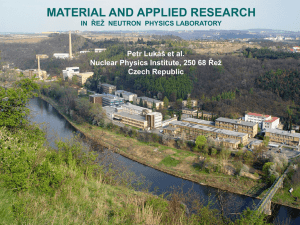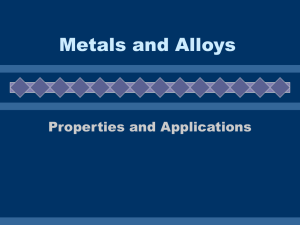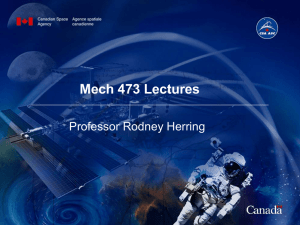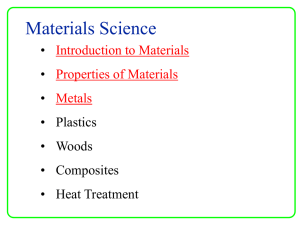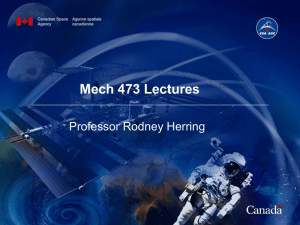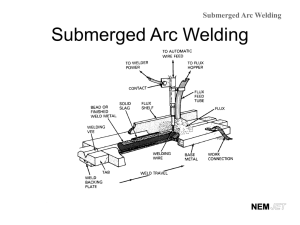High Temperature Atmospheric Reactions For high temperature
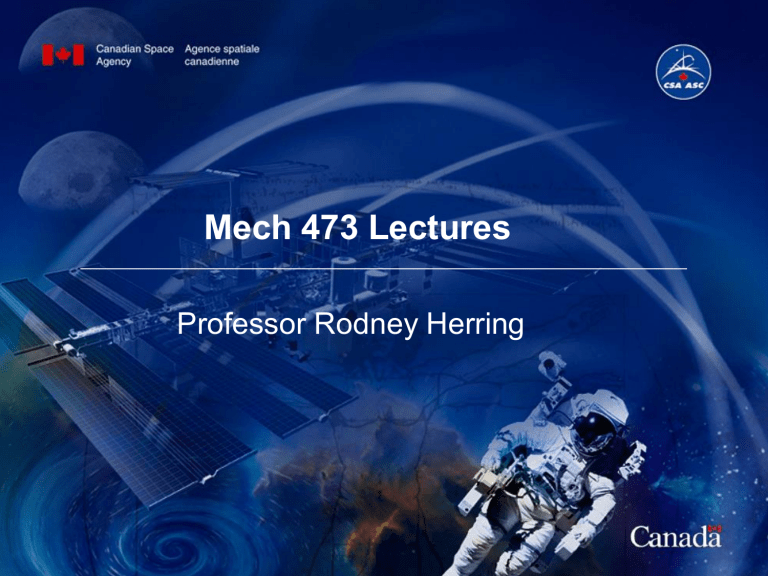
Mech 473 Lectures
Professor Rodney Herring
High Temperature Atmospheric Reactions
For high temperature applications, materials must be resistant to oxygen.
In this process, a clean metal surface reacts with oxygen in the atmosphere to form an oxide scale on the surface.
Further reaction depends on the properties of the scale, which separates the two reactants.
High Temperature Atmospheric Reactions
Steels having the BCC structure tend to form an oxide scale .
Steels (and FCC Aluminum) having the FCC structure tend to form pits if and when they corrode.
How is a scale different than a pit?
How does these types of corrosion affect the performance of the steel?
scale oxide reduces the thickness of the steel pits form surface cracks, which can reach a critical crack size
High Temperature Atmospheric Reactions
Why might there be this difference in oxide morphology that depends on crystal structure?
Dislocations!
Dislocations form grain boundaries as a network and act as pipes for diffusion, which is required for corrosion.
Dislocations in BCC materials do not react with each other to form extended networks so they remain localized at the surface creating a scale.
Dislocations in FCC materials react with each other to form extended networks that can extend deep into the material from the surface enabling the formation of pits.
High Temperature Atmospheric Reactions
Atomic Scale Reactions
For irons alloys, in the FeO scale there is a defect structure containing Fe 2+ ion vacancies , which permit the rapid outward diffusion of Fe 2+ ions.
Electrons can also diffuse through the FeO structure by hopping from an Fe 2+ ion to an Fe 3+ ion, which makes FeO an electrical conductor . This enables steel to rust extremely rapidly in some corrosive environments.
Plain carbon steels thus have poor resistance to oxidation at high temperatures.
Oxidtion of Iron Carbide in Steels
Plain carbon steels are composed of a –iron (ferrite) and pearlite
(laminar structure of ferrite and cementite).
In addition to the oxidation of Fe to form the FeO scale, the carbon in cementite (Fe
3
C) oxidizes to form CO, which evolves or evaporates as a gas .
Since carbon diffuses more rapidly in the steel than Fe, a carbide depleted region forms near the surface , which creates a decarburized zone .
The decarburized zone has a lower hardness than the interior of the sample.
Ferrite + pearlite Ferrite only
Protective Oxide Coatings
The following oxides have tightly bonded ceramic structures and form strongly adherent and non-porous films on various metal substrates.
Al
2
O
3
TiO
2
– Alumina
– Titania
ZrO
2
– Zirconia
Cr
2
O
3
– Chromia
Alumina forms a protective film on Al alloys at room temperature, which protects them from further oxidation and from aqueous corrosion .
However the use of Al alloys at high temperatures is ruled out by its relative low melting temperature of 660 o C . Al alloys are not used above 400 o C.
Protective Oxide Coatings (cont’d)
Titania and Zirconia protect their respective metals from corrosion at room temperature and also provide oxidation resistance at temperatures up to about 600 o C .
Titania and Zirconia coatings are also very effective for protecting ferrous alloys and superalloys at temperatures above 1000 o C .
While Chromia effectively protects metallic Chromium from oxidation, however, due to the high cost of Cr metal, it is mainly used as chromium plating and not as the bulk material.
Chromia is mostly used for protecting stainless steels from both room temperature corrosion and high temperature oxidation.
Stainless Steels
The essential property of stainless steels is their resistance to corrosion , especially in saline solutions, under oxidizing conditions.
These properties are the result of a thin adhesive film of Cr
2
O
3
, which forms on the surface at room temperature and which is self healing when scratched or otherwise damaged.
In general a minimum concentration of 12% Cr is require d to obtain a film that completely covers the exposed surface of a sample, so we’ll start this study with an examination of the composition of the alloys and then the Fe-Cr phase diagram .
“Stainless Steels”
Stainless steels are another class of ferrous alloys, which have been made for and are used because of their excellent corrosion resistance.
A true stainless steel has at least 12% Cr in the steel. This steel is exposed to oxygen, which forms a thin, stable Cr
2
O
3 the surface, which is very corrosion resistant.
coating on
The Cr
2
O
3 in the steel is very stable against attack by a number of chemicals and electrolytic corrosion actions. It is self healing if damaged.
•
•
In general, there are four types of stainless steels based on their crystal structure and strengthening mechanisms. They are:
• Ferritic stainless steels
• Martensitic stainless steels
Austenitic stainless steels
Precipitation-hardened stainless steels
We shall see some examples of these in the Tables (next few slides).
L – refers to low carbon, which offers protection against corrosion.
C – refers to high carbon, which enables hardenability giving a higher strength.
“PH” stands for “precipitation hardened”.
Cb is an old symbol for Niobium, which used to be called Columbium.
Fe-Cr Phase Diagram
Cr is a ferritic stabilizer .
The austenite phase is thus condensed into a small “ gloop”
, which extends out to 16% Cr over the range of temperature
900 – 1400 o C.
At concentrations greater than 16% Cr, the a –Fe and d
-Fe phases are not distinguishable and a common a –phase extends all the way to 100% Cr.
The 50/50 composition orders at temperatures below ~900 o C to form the s –phase, which causes embrittlement in stainless steels .
What does ‘orders’ mean? Is s stochiometric or non-stochiometric?
Carbide Phases in Stainless Steels
The phases formed in slowly cooled stainless steels are shown below as a function of carbon and chromium content.
Up to 15%, Cr can enter cementite without changing its structure, to form (FeCr)
3
C , which is the carbide present in low alloy steels .
The next carbide is
(FeCr)
7
C
3
, which contains a minimum of 35% Cr .
This is the carbide formed in high-carbon highchromium tool steels .
(FeCr)
4
C, which contains
> 70% Cr, is the carbide normally found in stainless steels .
(Fe-18%Cr-8%Ni)-C Phase Diagram
Nickel stabilizes the austenite, g –phase in stainles steels (SS)
.
When 8% Ni is added to an 18% Cr steel – 18/8 SS – the g
-phase is stable down to room temperature at very low C
– the three phase ( a
+ g
+ carbide) eutectoid region is at lower temperatures.
The high temperature d
ferrite is also very restricted.
( a
+ g
+ carbide) eutectoid
The 300 Series of Austenitic Stainless Steels
These alloys are based on a minimum of 18% Cr – 8% Ni with a maximum of 0.15C
.
Minimum grades are least expensive for bulk applications such as kitchen sinks.
20% Cr – 10% Ni have better properties for higher specifications such as very low carbon grade (L), eg., < 0.03% C is prevents the formation of (CrFe)
4
C at grain boundaries, which depletes the Cr below 12% in the bulk .
Addition of 2-3% Mo enhances corrosion protection in neutral salt solutions. As well, very low carbon grade < 0.03% C is required for welded components
Addition of Ti (5xC) or Nb (10 x C), enables carbon to be increased to 0.08% for welded products by forming TiC or NbC instead of
(FeCr)
4
C.
Microstructures are shown next slide.
The 300 Series of Austenitic Stainless Steels
Microstructures of 302 Stainless Steel containing 18Cr – 8Ni – 0.11C
Quenched from 985 o C
Austenite + annealing twins
(boundaries are lines) plus undisolved carbides
(mag – 1000x)
Quenched from 1205 o C
Course Austenite + annealing twins and no undissolved carbides
(mag – 1000x)
Carbide Precipitation at Grain Boundaries
The precipitation of (CrFe)
4
C , which contains 70 % Cr, at grain boundaries causes the concentration of Cr in the adjacent austenite to fall below 12% , which degrades the corrosion resistance properties of the steel.
The optimum temperature for precipitation of (CrFe)
4
C is around
650 o C, which is attained in the heat affected zone adjacent to a fusion weld . You can ask Steve Ferguson about this on Monday.
Stainless steels with carbon as low as 0.15% can thus suffer “ weld decay
”.
It can be eliminated by 1) lowering carbon to 0.03%, or 2) use Ti or
Nb to remove the carbon as TiC or NbC, without lowering the
Cr content of the austenite. (see micrographs next page).
Precipitation of (CrFe)
4
C at Grain Boundaries
Quenched from 1150 o C
Reheated 24 h at 650 o C
Carbides at grain boudaries
( mag – 240x )
Quenched from 1150 o C
Reheated 24 h at 650 o C
Carbides at grain boundaries
( mag – 1000x )
Precipitation of
(CrFe)
4
C
at Grain Boundaries
The concentration profile of Cr in the matrix adjacent to a precipitate of (CrFe)
4
C is given below.
The Cr level falls from 18% to 7-8% , which is well below the 12% limit for effective corrosion protection.
Oxidation Resistant Stainless Steels
In order to maintain stability of the austenite phase the Cr was increased to 22 – 26% Cr with Ni of 12 – 22%. The addition of
Ni gives increased resistance to oxidation at high temperatures.
These steels are very expensive and only used for special applications.
(see micrograph next page)
Oxidation Resistant Stainless Steels
Micrograph of a welded joint in 20Cr – 12Ni Stainless Steel x50
The structure of the original metal is shown on the left .
The fine-grained dark structure on the right is the weld material (filler) .
In the centre where the metal has been heated close to its melting point the structure is largely austenitic with some darker alloyed ferrite.
In the heat affected zone, the austenite shows pronounced grain growth and is thus weaker than the original fine grained structure .
Pseudo-binary (Fe – 12%Cr)-C Phase Diagram
Carbon is soluble in Fe-Cr austenite and increases the Cr limit of the g –loop .
Hardenable cutlery steels , which contain the minimum 12% Cr , are described in terms of a pseudo-binary (Fe + 12%Cr)-C phase diagram.
The g
-field is severely constricted compared to the Fe-C diagram .
•
The maximum solubility of C is 0.7% and the eutectoid is at 0.35% C .
•
In addition, the eutectoid temperature (range) is raised to >800 o C .
Two forms of carbide are in equilibrium with the g –phase, ie., the (CrFe)
4
C and (CrFe)
7
C
3
, depending on the carbon content.
eutectoid temperature (range)
The 400 Series of Heat Treatable Stainless Steels
These steels are based on 12-16% Cr with various amounts of Carbon .
Low carbon grades containing up to 0.2 C containing up to 12-13% Cr are hardenable by air quenching to form a low-carbon martensite and are used for cutlery .
High carbon grades containing 0.6-1.2 C and 16-18 Cr form much harder highcarbon martensite on quenching and are used for surgical instruments .
Low carbon grades with up to 0.2 C and 14-18% Cr are ferritic and can only be hardened by 1) cold work or 2) precipitation of carbide . Recall Cr is a ferrite stabilizer.
Air cooled from 790 o C ferrite plus carbide x1000
Air cooled from 955 o C. Low carbon martensite x1000
Precipitation Hardened Ferritic Stainless Steels
These steels, which contain ~17% Cr with very low carbon of 0.04 –
0.07 C , have good corrosion resistance and high strength .
The 17 – 4 PH* ( 4% Ni ) alloy is transformed to low carbon martensite on cooling from austenite and is hardened by ageing at 480 o C due to the precipitation of Al-Ti or Nb-Cu compound.
The 17-7PH ( 7% Ni ) alloy is semi-austenitic and requires a more complicated series of treatments to produce a precipitationhardened martensite.
• 5-20% d
-ferrite is present after this steel is quenched from the solution annealing temperature of 1065 o C as Al is a strong ferrite former .
• It is easily worked in this condition but it rapidly work hardens because of its low Ni content.
• It is hardened by ageing at 565 o C when an Al-based compound is precipitated .
•
An ageing treatment at 510 o C gives a higher strength at the expense of lower ductility .
* - PH stands for “ precipitation hardened
”.
Mechanical Properties of Wrought Stainless Steels
General Thermomechanical Treatments for Steels
These treatments increase the strength of a steel by deformation before, during, or after the austenite transformation to martensite or to a ferrite + carbide aggregate.
We will discuss each in turn.
Deformation
“before”
Austenite transformation
Type 1a refers to normal hot working to save energy and to permit relief of deformation stresses by recovery and recrystallization processes. (cont’d next page)
Thermomechanical Treatments for Steels
Type 1b , ie., deformation before transformation to martensite , called ausforming , can only be applied if the composition of the steel results in a bay between the pearlite and bainite reactions.
After the deformation, the steel is quenched to room temperature to form martensite.
This treatment gives a greater improvement in both yield and ultimate strengths compared to any other heat treatment while retaining a reasonable ductility.
The results for steel H11 show that a deformation of 94% causes a 30% increase in strength with relatively little loss of ductility .
The austenitization temperature, the grain size and the exact temperature of deformation do not appear to be significant variables for this process.
The carbon content linearly increases the strength and lowers the ductility .
It is thought that carbon diffuses to dislocations generated in the deformed austenite and that this causes additional deformation of the martensite resulting in increased hardness without decreased ductility. (cont’d next page)
Thermomechanical Treatments for Steels
Type 1c, ie., deformation before transformation to ferrite-carbides.
This causes a fine austenite grain size by recrystallization before transformation resulting in smaller colonies of pearlite or bainite with a consequent increase in notch toughness.
• This process is regularly applied to plate and pipe steels.
Deformation
“during”
Austenite Transformation
Type 2a, ie., deformation during transformation to martensite.
This is most often applied to austenitic stainless steels and results in increase strengths due both to 1) the transformation to martensite (ie., phase hardening ) and 2) the strain hardening of the austenite that occurs at the lower temperature of working.
Type 2b, ie., deformation during transformation to ferrite + carbide.
This results in improved strength through microstructural refinement .
The deformation increases the number of nuclei for the transformation resulting in a fine dispersion of the carbide phases .
Thermomechanical Treatments for Steels
Deformation
“after”
Austenite Transformation
Types 3a and 3b treatments induce strengthening by deforming the martensite and thus can only be applied to low carbon steels .
Further strengthening is obtained by precipitation of carbide from the martensite and by the formation of compounds from other alloy additions.
Type 3c strengthening occurs primarily by dispersion of the carbide phases.
What is the difference between precipitation and dispersion?
Composition of Ultrahigh-Strength Steels
Ultrahigh-strength steels have been developed for demanding tasks at temperatures near the ambient , ie., from –100 to +200 oC.
Mechanical Properties of Ultrahigh-Strength
Steels
Why is the endurance limit given in cycles and not as strength (i.e., MPa or psi)?
Ultrahigh-Strength Steels
These steels have strengths in the range 1600-2000 Mpa with elongation greater than 7.0% to provide adequate ductility.
The first six of these steels contain 0.3-0.4 %C to give a relatively hard martensite without excessive brittleness . Further strength is obtained by secondary hardening during tempering.
AISI 4340 is a medium carbon steel alloyed with Ni and Cr so that martensite is formed by oil quenching and toughness is obtained by tempering .
4330V is a steel of similar composition with additional V , which raises the coarsening temperature so that the heat treated steel has a finer grain size .
AISI H11 is a hot worked tool steel with a low enough carbon content of 0.4% to give acceptable ductility.
• The Cr and Mo cause it to air harden and induce secondary hardening during tempering .
• This steel requires preheating before welding to reduce cracking due to martensite formation and thermal stresses .
(cont’d next page)
Ultrahigh-Strength Steels
DCA is another 0.4% carbon steel with the addition of Cr and Mo to enable oil quenching and induce some secondary hardenng during tempering .
• It has lower ultimate strength than H11, but it has a higher yield point and a slightly greater ductility .
HP9-4-30 is a 0.3 %C Ni-Co steel with a slightly lower strength , but superior ductility than H11 and DCA in the quenched and tempered condition.
•
The Co increases the amount of martensite formed at room temperature and also strengthens the tempered martensite by solid solution .
• The second group of steels, ie., HP 18 Ni, 17-4PH, and 17-7PH , form low carbon martensite, which are less hard but inherently more tough than the o.4 %C martensites.
• These tempered martensites are hardened either by cold work and/or precipitation hardening .
18 Ni steel forms a mixture of martensite and retained austenite on slow cooling from 815 o C.
The low-carbon, high-nickel martensite can be cold-rolled to 80-90% without cracking and subsequent ageing at 480 o C precipitates a hardening phase based on Co-Ti . As this material is readily weldable and has a high fracture toughness , it is very suitable for high strength pressure vessels . (cont’d)
Ultrahigh-Strength Steels
17-4PH and 17-7PH are high strength precipitation hardening stainless steels that maintain good corrosion resistance as there is no Cr loss from the matrix during the precipitation process
